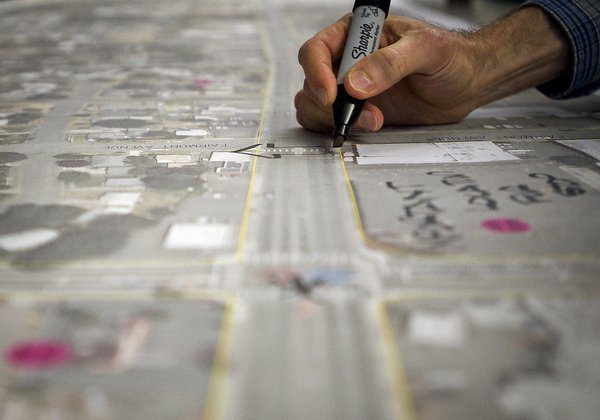A citizen committee signaled Thursday that it’s not interested in pursuing bus-only lanes on any part of a proposed bus rapid transit line in Vancouver.
The Corridor Advisory Committee helping shape the idea indicated last year that dedicated bus lanes wouldn’t work for Fourth Plain Boulevard, where the bulk of the system would run. On Thursday, March 29, the group appeared to agree that Fort Vancouver Way near Clark College isn’t a good fit, either. College officials and project consultants worried that reducing car lanes would put too much of a squeeze on traffic and parking at the busy campus.
But several questions remain unanswered before the group makes a recommendation to C-Tran and other local leaders this spring. Committee members still haven’t settled on which lane the enhanced bus system should run, or how far it should stretch east of downtown.
“My opinion is, let’s go as far as we can — as long as we can do it right,” said committee member Jennifer Halleck.
Bus rapid transit works by combining several upgrades into a revamped bus system designed to move passengers more smoothly and reliably. Features include larger vehicles, raised boarding platforms and specialized traffic signals. Other BRT systems have used dedicated bus lanes and fixed “guideways,” though that doesn’t appear likely here.
C-Tran first floated the idea early last year, and has zeroed in on its busiest corridor in Fourth Plain. If implemented, a BRT system would replace the agency’s existing No. 4 and No. 44 bus routes. But planners are comparing everything against a no-build option, which would essentially leave Fourth Plain and Fort Vancouver Way as is.
The committee exploring the idea has narrowed possible lane configurations along the proposed line this month. It’s come down to two options: putting BRT vehicles in the right lane for curbside service, or putting them in the left lane to serve new stations in the median of the road. Both options would operate mixed with vehicle traffic.
Committee members still appear split over which way to go. Some favored the median-station option as safer for pedestrians and bicyclists, and possibly faster-moving for BRT. But others said that plan would create havoc for traffic for businesses. Project consultant Stefano Viggiano noted median stations could affect access to as many as 18 driveways along the corridor. That was enough for Anderson Glass owner Bill Steiner to support curbside stations.
“I would rather have a bus stop in front of my business than not be able to turn into it,” Steiner said.
As for length, a BRT system would start in downtown Vancouver and run at least to Vancouver Mall along Fourth Plain. The committee has also explored whether it should extend beyond that, likely to Northeast 121st Avenue or Northeast 162nd Avenue.
Preliminary analysis shows that extending BRT to 162nd would boost ridership, Viggiano said. It would also significantly boost the cost. A BRT system to Westfield Vancouver mall would carry a price tag of $35 million to $50 million, according to C-Tran, while the longest option to 162nd would cost $45 million to $60 million.
Committee member Dick Malin suggested planners should only consider building out that far if it provides real benefit to the area and its anticipated growth. The agency shouldn’t build something extra just because it can, he said.
C-Tran officials are banking on federal funds to cover 80 percent of the capital cost for BRT. Annual operation costs may be up to voters, if a planned sales tax measure lands on the ballot this year.
The committee could make its preferred recommendation in May. But that’s far from the final word — any proposal will still go before the C-Tran board. And planners will continue to carry forward the no-build option and smaller fixes that could improve the corridor at lower cost.
If C-Tran ultimately pulls the trigger on BRT, construction could begin as soon as 2013 or 2014.
Eric Florip: 360-735-4541; http://twitter.com/col_enviro ; eric.florip@columbian.com.




